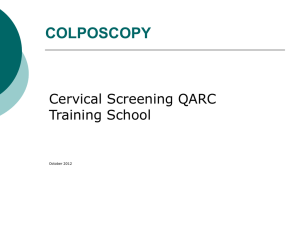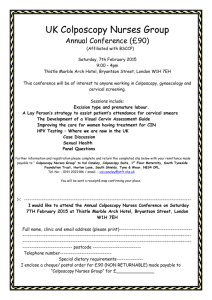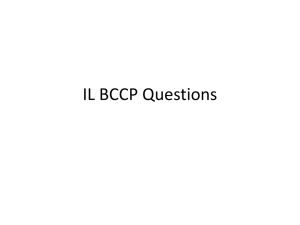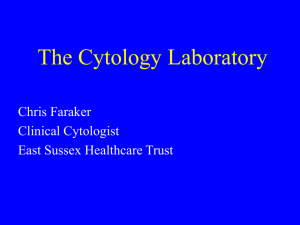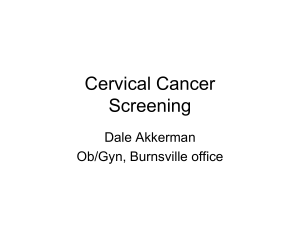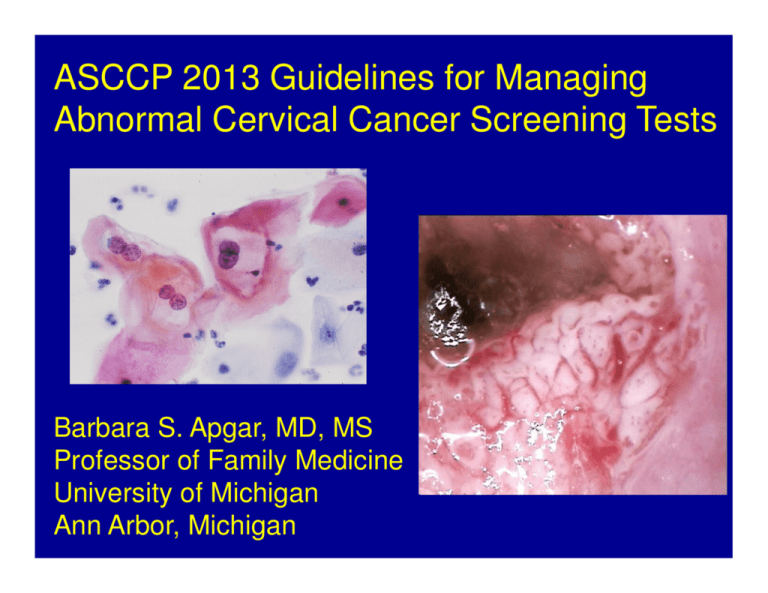
ASCCP 2013 Guidelines for Managing
Abnormal Cervical Cancer Screening Tests
Barbara S. Apgar, MD, MS
Professor of Family Medicine
University of Michigan
Ann Arbor, Michigan
Disclosures
1. Apgar B, Brotzman G, Spitzer M. Integrated Text and Atlas
of Colposcopy. Elsevier Publishers, 2004, 2008.
2. Brotzman G, Spitzer M, Apgar B. Colposcopic Image
Library on CD. SABK, Inc 2004.
3. ASCCP Board of Directors. 2007-current.
Permission obtained from ASCCP to use algorithms
What are we
going to talk
about today?
Principles of 2013 Management Guidelines
Preventing all cervical cancer is unrealistic.
No screening test has 100% sensitivity.
Precursor disease can recur post management/treatment.
Risk of persistent oncogenic HPV.
Women at similar risk for cancer are managed the same.
ASC-US, LSIL (“lesser”)
ASC-H, HSIL, AGC (“greater”)
Potential harms of overzealous management.
Pain/bleeding from procedures.
Treatment-related pregnancy complications.
“Similar Management of Similar Risks”
ensures simplified, consistent management
for different test result combinations
Can be initial management or follow-up.
Is this“ similar
management
of similar
risks”?
Cervical Intraepithelial Neoplasia
(CIN)
CIN 1 (histologic LSIL)
CIN 2 (histologic HSIL)
CIN 3 (histologic HSIL)
You will see less “CIN” as CIN is
converted into LSIL and HSIL
Screening targets
CIN 3 is a true precancer, 30-50% progress
to cancer over 30 years.
Observation is unacceptable since it cannot be
predicted which CIN 3’s will invade.
CIN 2 is a collection of CIN 3 and CIN 1
50% regression rate, low risk of invasion
Observation acceptable, especially in young women
CIN 1 is a transient or stable HPV infection
with minimal cancer risk: DO NOT TREAT!
How risk is managed
High risk >>> treat
Low risk >>> observe
Intermediate risk >> manage by level of risk
Short interval rescreening.
Molecular triage (HPV, genotyping, biomarker)
Definitions of high/low/intermediate risk are
arbitrary, based on balancing risks of
intervention vs. risks of cancer
Cervical cancer screening guidelines
Age 30-65. Testing with cytology alone every 3 years or co-testing
with cytology and testing for high-risk HPV types every 5 years.
Co-testing “preferred” and cytology “acceptable” by all but USPSTF.
USPSTF says either acceptable
1.
2.
3.
4.
Saslow et al. ACS/ASCCP/ASCP. CA Cancer J Clin 2012; 62: 147-72
and AJCP 2012; 137: 516 – 542.
Moyer VA, et al. USPSTF. Ann Int Med 2012; 156: 880-91
ACOG Practice Bulletin #131, November 2012
NCCN Cervical Cancer Screening Guideline v. 2-2012. www.NCCN.org
Proportion of Co-Test Results in
331,061 Kaiser women > 30 years
3.7%
1.4%
2.4%
Discordant
92.5%
Katki HA, et al. Lancet Oncol 2012; 12: 663
35 year old G1P1 has a negative Pap test and positive HPV
testing. She was previously screened with Pap's only but has
had no screening in 5 years. What is the next step?
1. Cotesting in 1 year.
2. Routine screening (cotesting) in 5 yrs.
3. Immediate colposcopy.
2013 ASCCP management guidelines
Wright TC, et al. J Lower Genital Tract Disease, 2007; 11: 201-222 and 223-239
She returns in one year. Cotesting results
show Pap – HPV –
What is the next step?
1. Repeat cotesting in 1 year.
2. Repeat cotesting in 3 years.
3. Pap only in 3 years.
2013 ASCCP consensus guidelines
Women > age 30, Pap -, HPV +
Wright TC, et al. J Lower Genital Tract Disease, 2007; 11: 201-222 and 223-239
She returns in 3 years and her
cotesting is Pap - HPV +
What does she do now?
1. Go back and start all over with
cotesting in 1 year.
2. Immediate colposcopy.
2013 ASCCP mgt guidelines
Women > age 30, Pap - HPV +
NO
Wright TC, et al. J Lower Genital Tract Disease, 2007; 11: 201-222 and 223-239
HPV Genotyping
Both DNA and mRNA tests available
Prognostic information seems similar.
5 year risk of CIN2+ if HPV 16 + = ~10%
Risk of CIN2+ is lower if HPV 18 , but there is
association for adenocarcinoma.
Bottom line: ASCCP guidelines show genotyping
acceptable without recommending for or against use
Allows for clinician discretion and patient choice
42 year old woman is Pap – HPV +
You decide to genotype her and she is
HPV 16 and 18 negative.
What is the next step?
1. Cotesting in 1 year.
2. Cotesting in 3 years.
3. Colposcopy.
HPV -
Her cotesting in one year is
Pap – HPV +. What do you do now?
1. Immediate colposcopy.
2. Repeat cotesting in 1 year.
3. Repeat cotesting in 3 years.
Pap HPV +
Women > age 30, genotyping
Pap HPV +
Wright TC, et al. J Lower Genital Tract Disease, 2007; 11: 201-222 and 223-239
ASCCP Management
Guidelines, 2012-2013
22 year old presents for her first Pap. She has
been sexually active since age 17 (3 partners).
You decide to do cotesting because she is
sexually active. She is Pap negative but HPV +.
What do you do now?
Pap in one year. No HPV testing.
Pap in 3 years. No HPV testing.
Cotesting in one year.
Genotyping now.
2012 Consensus Guidelines:
Screening Frequency
Age 21-29. Testing with cytology alone every 3 years.
Co-testing should NOT be performed for women under age 30.
1.
2.
3.
4.
Saslow et al. ACS/ASCCP/ASCP. CA Cancer J Clin 2012; 62:
147-72 and AJCP 2012; 137: 516 – 542.
Moyer VA, et al. USPSTF. Ann Int Med 2012; 156: 880-91
ACOG Practice Bulletin #131, November 2012
NCCN Cervical Cancer Screening Guideline v. 2-2012.
www.NCCN.org
Managing Women 21-24
Kaiser data
3 cancers noted in 133,947 women ages 21-24
HPV infection incidence peaks in this age group.
Likelihood of future pregnancy is high.
Most CIN2 in this age group will regress.
Be conservative, conservative, conservative!
22 year old with ASC-US. This is her first
Pap. You requested reflex HPV testing.
She is HPV +
What is the next step?
1. Colposcopy now.
2. Pap in 1 year.
3. HPV testing in 1 year.
Management of Women Ages 21-24 years with either Atypical Squamous Cells of
Undetermined Significance (ASC-US) or Low-grade Squamous Intraepithelial Lesion (LSIL)
Women ages 21-24 years with ASC-US or LSIL
Repeat Cytology
HPV Positive
@ 12 months
Preferred
Negative, ASC-US
or LSIL
Reflex HPV Testing
Acceptable for ASC-US only
ASC-H, AGC, HSIL
HPV Negative
Repeat Cytology
@ 12 months
Negative x 2
> ASC
Colposcopy
Routine
Screening
Routine
Screening
© Copyright, 2013, American Society for Colposcopy and Cervical Pathology. All rights reserved.
23 year old G1P1 has a Pap showing HSIL. Her
previous Pap was ASC-H (PCP records) 2 years ago.
She did not return until now.
What is the next step?
1. Repeat Pap in 1 year.
2. Ask for HPV testing.
3. Ask for genotyping.
4. Immediate colposcopy.
Management of Women Ages 21-24 yrs with Atypical Squamous Cells, Cannot Rule Out
High Grade SIL (ASC-H) and High-grade Squamous Intraepithelial Lesion (HSIL)
Colposcopy
(Immediate loop electrosurgical excision is unacceptable)
No CIN2,3
CIN2,3
Two Consecutive
Cytology Negative
Results
Observation with
colposcopy & cytology*
and
@ 6 month intervals for up to 2 years
No High-grade
Colposcopic
Abnormality
High-grade colposcopic
lesion or HSIL
Persists for 1 year
Other
results
HSIL
Biopsy
Persists for 24 months with
no CIN2,3 identified
CIN2,3
Figure 9
Routine
Screening
*If colposcopy is adequate and
endocervical sampling is negative.
Otherwise a diagnostic excisional
procedure is indicated.
+Not if patient is pregnant
Manage per
ASCCP Guideline
Diagnostic
Excisional
Procedure+
(If no CIN2,3,
continue observation)
Manage per
ASCCP Guideline
for young women
with CIN2,3
© Copyright, 2013, American Society for Colposcopy and Cervical Pathology. All rights reserved.
ASC-H and HSIL in Women Ages 21-24
Precancer risk higher than after ASC-US/LSIL
5 year CIN3+ risk
16% after ASC-H
28% after HSIL
5 year cancer risk
0% after ASC-H
0% after HSIL
Bottom line: cancer unlikely during extended
observation
TREAT women with high risk
of
developing invasive disease
OBSERVE women who are not
at high risk of developing
invasive disease
and
protect them from over-treatment
Treatment in young women
Treatment can have adverse consequences on
future pregnancy.
CIN 2 can regress – up to 49%.
Risk of progression is real but usually takes
significant time.
Treat if CIN 2 present for 2 years.
Treatment recommended for CIN 3.
Risk of progression is high enough to justify
potential risks to future pregnancy.
23 year old presents for a Pap. She had a “slightly bad”
Pap during pregnancy at age 18. She does not know the
result and did not follow-up. She is referred to colposcopy
for HSIL cytology. What is your colposcopic impression?
1. Normal
2. Low grade
3. High grade
4. Cancer
Biopsies showed LSIL (CIN 1) and HSIL
(CIN 2). ECC negative. What is the next step?
1. Colposcopy and cytology at 6 and 12
months.
2. LEEP.
3. Cotesting in one year.
Management of Young Women with Biopsy-confirmed Cervical Intraepithelial Neoplasia Grade 2,3 (CIN2,3) in Special Circumstances
Young Women with CIN2,3
Either treatment or observation is acceptable, provided colposcopy is adequate. When CIN2 is specified,
observation is preferred. When CIN3 is specified, or colposcopy is inadequate, treatment is preferred.
Observation - Colposcopy & Cytology
@ 6 month intervals for 12 months
2x Cytology Negative
and Normal Colposcopy
Cotest in 1 year
Both tests negative
Colposcopy worsens or
High-grade Cytology or Colposcopy
persists for 1 year
Either test
abnormal
Repeat
Colposcopy/Biopsy
Recommended
Treatment using Excision
or Ablation of T-zone
CIN3 or CIN2,3 persists for 24 months
Treatment Recommended
Cotest in 3 years
Figure 17
© Copyright, 2013, American Society for Colposcopy and Cervical Pathology. All rights reserved.
HSIL persists for 12 months. The lesion is
larger on colposcopy. Biopsy shows CIN
3. What is the next step?
1. Repeat colposcopy and biopsy in 6
months
2. LEEP
3. Cotesting in one year.
Management of Young Women with Biopsy-confirmed Cervical Intraepithelial Neoplasia Grade 2,3 (CIN2,3) in Special Circumstances
Young Women with CIN2,3
Either treatment or observation is acceptable, provided colposcopy is adequate. When CIN2 is specified,
observation is preferred. When CIN3 is specified, or colposcopy is inadequate, treatment is preferred.
Observation - Colposcopy & Cytology
@ 6 month intervals for 12 months
2x Cytology Negative
and Normal Colposcopy
Cotest in 1 year
Both tests negative
Colposcopy worsens or
High-grade Cytology or Colposcopy
persists for 1 year
Either test
abnormal
Repeat
Colposcopy/Biopsy
Recommended
Treatment using Excision
or Ablation of T-zone
CIN3 or CIN2,3 persists for 24 months
Treatment Recommended
Cotest in 3 years
Figure 17
© Copyright, 2013, American Society for Colposcopy and Cervical Pathology. All rights reserved.
Let’s
discuss
adult
women
now……
Managing ASC-US in adult women
Up to 2/3 are HPV-associated
HPV+ more frequent in younger women
>60% ages <25 vs. <25% ages 45-55
More frequent among those with more
partners
HPV triage of ASC-US more cost-effective
than repeat cytology
Arbyn M et al Vaccine 2006;24:S3:78-70
Eltoum IA et al Cancer 2005;105:194-99
Management of Women with Atypical Squamous Cells of
Undetermined Significance (ASC-US) on Cytology*
Repeat Cytology
@ 1 year
Acceptable
Negative
HPV Testing
No colpo
Preferred
HPV Positive
> ASC
(managed the same as
women with LSIL)
Routine
Screening+
*Management options may vary if the
woman is pregnant or ages 21-24
+Cytology at 3 year intervals
Colposcopy
Endocervical sampling preferred in women
with no lesions, and those with inadequate
colposcopy; it is acceptable for others
HPV Negative
Repeat Cotesting
@ 3 years
Manage per
ASCCP Guideline
Figure 4
© Copyright, 2013, American Society for Colposcopy and Cervical Pathology. All rights reserved.
NE
W
What has changed in adult women
with ASC-US from prior guidelines ?
Colposcopy is not immediate option (2006).
HPV- ASC-US insufficient to exit from
screening at age 65.
- Repeat cotesting in one year.
28 year old G1P1 has had 3 normal Pap tests.
She now has LSIL. What is the next step?
1.
2.
3.
4.
Colposcopy.
Reflex HPV testing.
Genotyping.
Repeat Pap in 1 year.
Management of Women with Low-grade Squamous Intraepithelial Lesions (LSIL)*
LSIL with no HPV test
LSIL with negative HPV test
LSIL with positive HPV test
Preferred
Acceptable
Colposcopy
Repeat Cotesting
@ 1 year
≥ASC
or
Cytology Negative
HPV positive
and
HPV Negative
Repeat Cotesting
No CIN2,3
CIN2,3
Manage per
ASCCP Guideline
Manage per
ASCCP Guideline
@ 3 years
* Management options may vary if the woman is
pregnant, postmenopausal, or ages 21-24 years
(see text)
Figure 6
© Copyright, 2013, American Society for Colposcopy and Cervical Pathology. All rights reserved.
Managing ASC-H in adult women
• > 60% are HPV+
– HPV triage relatively inefficient
– CIN3+ risk when HPV negative = 3.5% at 5 years
– CIN3+ risk when HPV+ = 25% at 5 years
Management of Women with Atypical Squamous Cells:
Cannot Exclude High-grade SIL (ASC-H)*
Colposcopy
Regardless of HPV status
No CIN2,3
Manage per
ASCCP Guideline
CIN2,3
Manage per
ASCCP Guideline
*Management options may vary if the woman is
pregnant or ages 21-24 years.
Figure 8
© Copyright, 2013, American Society for Colposcopy and Cervical Pathology. All rights reserved.
HSIL in adult women
• Immediate CIN3+ risk is 36%
• Risk rises to 47% at 5 years
– Justifies immediate excision when pregnancy
not at issue
• Bottom line: 6% of women ages 30-64 with HSIL
have cancer
Management of Women with High-grade Squamous Intraepithelial Lesions (HSIL) *
Immediate Loop
Electrosurgical Excision +
Or
Colposcopy
(with endocervical assessment)
No CIN2,3
CIN2,3
Manage per
ASCCP Guideline
* Management options may vary if the woman is
pregnant, postmenopausal, or ages 21-24
+
Not if patient is pregnant or ages 21-24
Figure 10
© Copyright, 2013, American Society for Colposcopy and Cervical Pathology. All rights reserved.
37 year old had a LEEP for CIN 3.
Margins clear. LEEP sample showed
CIN 3. What is the next step?
1. Colposcopy and cytology at 6 and 12 months.
2. HPV testing at 12 months.
3. Cotesting at 12 and 24 months.
4. Cotesting in 3 years.
Management of Women with Biopsy-confirmed Cervical Intraepithelial Neoplasia Grade 2 and 3 (CIN2,3) *
*Management options
will vary in special
circumstances or if the
woman is pregnant or
ages 21-24
†If CIN2,3 is identified
at the margins of an
excisional procedure
or post-procedure
ECC, cytology and
ECC at 4-6mo is
preferred, but repeat
excision is acceptable
and hysterectomy is
acceptable if reexcision is not feasible.
Adequate Colposcopy
Either Excision† or
Ablation of T-zone *
Inadequate Colposcopy or
Recurrent CIN2,3 or
Endocervical sampling is CIN2,3
Diagnostic Excisional
Procedure †
Cotesting at 12 and 24 months
2x Negative
Results
Any test abnormal
Repeat cotesting
in 3 years
Colposcopy
With endocervical sampling
Routine screening
Figure 16
© Copyright, 2013, American Society for Colposcopy and Cervical Pathology. All rights reserved.
Cumulative risk of CIN 2 +
following subsequent
negative follow-up tests
after tx for CIN 2,3 or AIS.
Katki HA et al. JLGTD
2013; 17(5):s78-84.
23 year old G1P1 has had no endocervical
cells on 2 recent negative Pap's.
What is the next step?
1.
2.
3.
4.
Pap in 1 year.
Pap in 3 years.
Request HPV testing now.
Colposcopy.
Cytology NILM* but EC/TZ Absent/Insufficient
Ages 21-29+
Age ≥30 years
HPV negative
HPV testing
(Preferred)
HPV unknown
Repeat cytology in 3
years (Acceptable)
HPV positive
or
Cytology + HPV test in 1 year
Routine screening
Genotyping
Manage per
ASCCP Guideline
*Negative for intraepithelial lesion or malignancy
+HPV testing is unacceptable for screening women ages 21-29 years
Figure 2
© Copyright, 2013, American Society for Colposcopy and Cervical Pathology. All rights reserved.
The
End…..
Thanks!
For More Information
Explanatory text available at J Lower Genital
Tract Dis 2013;17:S1-S27
Algorithms are available for free download at
www.asccp.org/consensus2012
Algorithm booklets
ASCCP guidelines app

